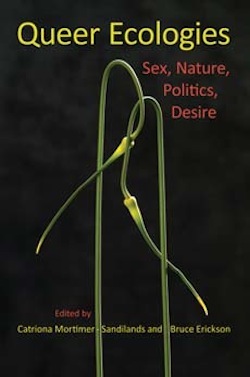Cate Sandilands
Symposium Lecture:
(Please click here or scroll down)
Cate Sandilands is a Professor in the Faculty of Environmental Studies at York University, where she teaches at the intersections of environmental literature and philosophy, queer and feminist studies, and ecological politics. The author of over 60 published works on topics ranging from national parks to lesbian communities, Walter Benjamin to honeybees, melancholic natures to monstrous plants, she is also known for The Good-Natured Feminist: Ecofeminism and Democracy (Minnesota, 1999), Queer Ecologies: Sex, Nature, Politics, Desire (Indiana, 2010), and the forthcoming Green Words / Green Worlds: Environmental Literatures and Politics (Laurier, TBA). She is currently working on two projects. The first is a scholarly monograph on Canadian author Jane Rule’s public intellectualism as represented by her novels, stories, essays, epistolary activism, and community engagement; it is entitled A Very Queer Citizen? Jane Rule’s Public Lives. The other is a work of literary nonfiction entitled Plantasmagoria, on people’s relations to plants (economic, ecological, aesthetic, sensual, cultural, philosophical, political) in urban centres like Toronto (Canada).
Queering Communities: Becoming (With) Plants
Touching the soft, new leaves of a lamb’s ear plant, have you ever felt a shiver of jouissance? Perhaps you have been swept away to your childhood self by the rich scent of an old rose as you walk past a sunny garden? Perhaps you have stood in awe of an oak tree that is far older than the nation that currently claims it as territory? Perhaps you have bitten into a warm tomato plucked from the container on your balcony and thought more carefully about what you are eating: skin, flesh, seed?
 Although we seldom think about plants consciously as sensual and sensate beings, such events demonstrate that they are very much part of our everyday phenomenal experience – and we of theirs, which we think about even less. Of course, they are our food, shelter, fuel, furniture, landscape, adornment, and even “ecosystem services.” But they are also our lively companions: we respond to plant activities, and they to ours, through complex communicative networks involving light, touch, movement, and especially chemistry, their rootedness making them especially adept at olfactory interactions. These interactions are both instantaneous and epochal; they are both individual and collective.
Although we seldom think about plants consciously as sensual and sensate beings, such events demonstrate that they are very much part of our everyday phenomenal experience – and we of theirs, which we think about even less. Of course, they are our food, shelter, fuel, furniture, landscape, adornment, and even “ecosystem services.” But they are also our lively companions: we respond to plant activities, and they to ours, through complex communicative networks involving light, touch, movement, and especially chemistry, their rootedness making them especially adept at olfactory interactions. These interactions are both instantaneous and epochal; they are both individual and collective.
This presentation will consider how thinking and being (and even eroticizing) with plants helps us to imagine queer forms of relationship and community. In particular, moving beyond hetero- and anthropo-centric assumptions about reproduction, kinship, and liveliness enables us to recognize and respond more thoughtfully and sensuously to the web of botanical relations in which we are always already enmeshed.
Portrait photo: © John McFetrick




